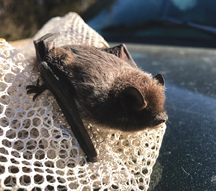
June 2020
Bats and Diseases

Let us talk about bats this month. Bats have certainly been in the news lately and I think it’s worth reminding ourselves of the facts about bats rather than the rumors. Why does it matter? Well, like most animals, the bat is very beneficial to us and our environment. But before I tell you all the good things about bats, let’s talk about the dangers AND the rumors associated with the ONLY flying mammal.
Let’s start by getting this first one right off the table; Vampire bats are not real vampires (lol); however, their diet does consist mainly of blood from their animal victims. This dietary trait is called hematophagy, which is practiced only by the three Vampire bat species. Although bats are a rabies vector species, incidents of rabies in bat populations are a lot less than what most folks believe. The most recent estimate is between .5 and 1 percent. What most people don’t realize is that bats don’t bite unless they are provoked.
Bats can however, carry several zoonotic diseases. Zoonotic diseases are diseases that can be passed from animals to humans. Bats have played a role in the transmission of at least 11 viruses, maybe even 12 if you count SARS (COV-2). The transmission of these diseases are NOT actually the bats fault, in fact the fault is once again humans. Research shows that disturbing animal habitats is usually what causes the transfer of a zoonotic disease to humans. Bats do still carry a lot of viruses, and this is because they have unique immune systems.
Without confusing you with the scientific explanation, let me try to make sense of this in a way more easily understood. It takes a huge amount of energy for these mammals to fly. This requires their bodies to produce fuel at a high rate, which creates oxidative stress, which in turn causes high levels of constant DNA damage. Genetic studies found mutations which boost the bats ability to detect and repair damaged DNA, and they can also prevent genetically damaged cells from replicating. This is probably why bats do not get cancers; something scientists are studying. However, in the bats case, damaged DNA triggers an immune response, and that’s called inflammation.
Now, the constant DNA damage is constantly being repaired by their amazing immune system, and their body’s acute inflammatory response. This leaves the bats experiencing super inflammation all the time, which isn’t good. The mystery is how the bat dampens or prevents this high level of constant inflammation from causing organ failure and even death. But remember, inflammation is the best way to protect the body from intruders, so the lack of it allows the bats to easily contract a number of other pathogens, leaving them reservoirs for a lot of viruses that are extremely dangerous to humans, like Filoviruses (Marburg or Ebola), Henipaviruses (Hendra or Nipah) and even Coronaviruses, like SARS, MERS, and the most recent COVID-19 (most likely). Another amazing fact about bats is, that of all the deadly viruses they can potentially carry and transmit, they themselves don’t get sick from them. The viruses can be found in their bodies, but they do not show any symptoms. Scientists have figure out a few biological reasons why, but still much remains to be learned from these nocturnal creatures.
Rabies is one virus the bat cannot seem to beat, even with its complex immune system. Another is the notorious White-Nose syndrome. This is a fungal disease that sneaks up on a bat when it hibernates. During a bats hibernation period, their amazing immune system is dampened, giving the disease an opportunity to infect the bat to a lethal level. And because they roost in colonies very close together, fly in groups very close together, and spray saliva when they are echolocating, they often spread these contagious diseases amongst themselves quite quickly.

New York State is home to nine different species of bats. The most common on eastern Long Island is the Little Brown Bat (Myotis lucifungus) and the Brown Bat, or Big Brown Bat (Eptesicus fuscus). The Myotis is the most commonly seen, while the Big Brown is most tolerant of cold temperatures and low humidity.

Bats make up a quarter of all mammals; 1200 species worldwide. The only mammal that can fly, bats have long fingers that are connected by a patagium similar to the Flying Squirrel; however, the flying squirrel doesn’t actually fly, but rather uses the patagium to create a parachute effect while gliding through the air. Another misconception is that bats are blind. They are not blind. They actually see very well, but also use echolocation by making and sending high-pitched sounds (not audible to humans) through their mouth and nose. The bats large ears detect the sounds that are bounced back from objects as thin as a strand of hair. This brings me to another rumor to dispel, bats do NOT get tangled in people’s hair. And if you’re wondering how bats get into your homes, it’s usually by accident.
Besides being great pollinators of plants, bats are great pest control managers. A single Brown bat can catch as many as 1200 mosquito-sized insects in 1 hour. Now, enjoy some outdoor fun on a warm summer’s night with outdoor lights on and you’re bound to draw insects to those lights. A perfect, and well-illuminated buffet for the hungry bats. Add in the element of folks going in and out of the house via the door by the light, sometimes leaving it open, and you have the perfect recipe for an early morning discovery of a bat flying around your interior living space. I get dozens of calls every summer.
Bats also LOVE to nest behind exterior facia boards up high on two story homes if there is a space to accommodate them. They can also gain access into an attic space through an unprotected gable vent or find their way into a fireplace via the chimney. From the facias, they can really make a mess on your siding with their poop. Bat poop (guano) is a fantastic fertilizer, but stains easily. During the US Civil War it was used to make gunpowder. A great solve for those whose facias have large gaps between them and the exterior wall is to stuff them with fine landscape drape netting. This is the lite gauge black plastic netting that is draped over short bushes to protect them from deer. Waded up, it easily fits snug into that space and leaves no room for bat roosting.
Then, I would suggest you keep them close to manage flying insect issues by hanging a bat house or two in your yard. These are easy to build or available at your local Agway or Amazon and are VERY effective. Also, to avoid having to call me at 3:00am (which you are always welcome to do), you might consider buying yourself a butterfly net to keep in the broom closet. This comes in handy when you need to remove a bat from your belfry,… or home. Simply catch it as you would a butterfly, and with gloves on carefully bring it outside STILL IN THE NET and then let it go. It’s really that simply, most of the time. Never ever provoke a bat to expose its teeth or handle it in a manner where you risk getting bit. There is no second chance when it comes to rabies, and although it is very rare on eastern Long Island, it’s always in the victim’s best interest to be treated for rabies after being bit. IF the animal is captured for testing, it’ll have to be killed whether it’s infected or not. It’s just a lose-lose situation for everyone. Safety is ALWAYS priority when handling any rabies vector species (bats, raccoons, foxes and skunks). But remember, ALL mammals can get rabies. This includes marine mammals.
So, as you can see, the bat is a very interesting creature and a species that still has much to teach us. Unlocking the secrets of the bats biology could solve human health related issues long pondered over. If you find an injured bat, I recommend you call a wildlife rescue volunteer or a wildlife rehabilitation center.
I hope everyone is staying healthy and safe. Please continue to take proper safety precautions and practice social distancing in public. Be smart, for you and for others. Thank you, and remember, Wildlife Matters!
~ Dell Cullum
Wildlife Rescue of East Hampton www.WROEH.org (844) SAV-WILD
Evelyn Alexander Wildlife Rescue & Rehab Center 631-728-9453

